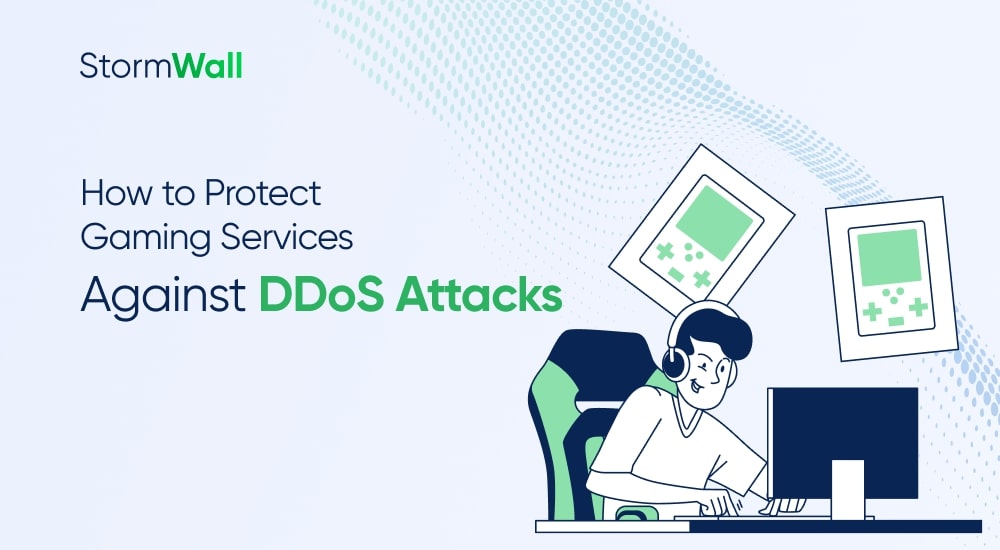Companies often assume that using DDoS protection services will completely shield them from attacks. Unfortunately, that’s not the case. DDoS protection isn’t a magic solution; it only works effectively when the services are designed to handle attacks. We call this ability “protectability”—it means an online service can withstand DDoS attacks with minimal cost, time, and effort.
In this article, we’ll look at ways to improve the resilience of gaming services that rely on TCP and UDP protocols. Most of these strategies also apply to other online services that require real-time user interactions. In particular, our recommendations can help protect IoT (Internet of Things) and IIoT (Industrial Internet of Things) systems that run on TCP and UDP.

Specifics of Protecting Gaming Services
Gaming services are typically complex, multi-component software systems. This complexity often leads to numerous vulnerabilities, making it difficult to fully safeguard them against all cybersecurity threats. Building a strong defense can be quite a challenge.
To ensure fast interactions with players, online games primarily use UDP and TCP protocols. However, this adds extra difficulties for DDoS protection service providers. Not all of them can effectively filter UDP traffic—some simply block it entirely when they detect an attack, without distinguishing between legitimate and malicious traffic.
This is why choosing the right protection provider is crucial. It’s important to ensure that the provider can deploy a DDoS protection sensor and properly filter service traffic, including UDP packets (if they are used).
Read How We Secured Rokogame Studios from DDoS >>
How Service Architecture Affects DDoS Protection
The way a gaming service is designed plays a huge role in how well it can withstand DDoS attacks. Let’s compare two examples—one with a weak architecture and one built for resilience.
Example 1: A Weakly Protected Service
Imagine an online game running on UDP. Both the game’s website and its server use the same IP address. Every time a player takes an action, the website updates the player count by querying its database.
An attacker can easily exploit this setup. They register as a regular player, analyze traffic patterns, and then generate fake requests that look just like real ones. If they launch an attack using a botnet, the game’s servers will waste resources processing fake traffic, eventually slowing down or crashing. Since the backend relies on the game server for player stats, the website will also go down when the server stops responding.
Would a DDoS protection provider be able to block the attack? Not easily—because the fake traffic looks almost identical to real player activity. The only way to detect it would be if each bot was generating an unusually high volume of traffic. But a smart attacker can use a large number of bots with low activity, making it nearly impossible to filter out the attack.
Example 2: A Resilient Service
Now, let’s look at a gaming service designed with strong DDoS protection in mind. Here’s what it does differently:
- The website, login system, and game server are hosted separately, reducing the risk of a single point of failure.
- The website and authentication services communicate securely via HTTPS.
- Each player is assigned a unique set of IP addresses from a distributed pool, preventing attackers from targeting a single entry point.
- The game server connects through multiple IPs and automatically switches if any become unreachable.
- Every login is verified using an authorization token and the player’s IP address.
With this setup, launching a successful DDoS attack is much harder. Attackers who don’t know the system’s exact structure will struggle to take it down, and mimicking real player behavior becomes nearly impossible.
Key Security Steps When Designing an Online Game
A game’s security is largely determined during the design phase. Fixing vulnerabilities after launch can be expensive and complicated. That’s why developers should prioritize cybersecurity from the start and collaborate with security experts and DDoS protection providers.
Here are some key steps to make your game more resilient to DDoS attacks:
1. Build a Secure Communication System
Design your game’s communication protocol so it can easily tell real players apart from bots. A good approach is to include hidden markers or rules that help verify legitimate users.Also, document your protocol carefully and share it with your DDoS protection provider so they can filter out attack traffic more effectively.
2. Protect Players’ IP Addresses
Keep real player IPs hidden from unauthorized users to prevent attackers from targeting them.
For example, one developer assigned players a new IP address after they reached level 20. The idea was that attackers wouldn’t bother investing the time to level up, so the most committed players would remain protected.
3. Don’t Hardcode IP Addresses
Avoid hardcoding your game server’s IP addresses, especially those used for external connections. DDoS protection providers assign new IPs, and if your old ones are hardcoded, switching to the protected ones will be difficult. Instead, use DNS-based addressing for flexibility.
4. Reduce Dependencies Between Game Servers
If different parts of your game depend too much on each other, an attack on one component could crash everything. For example, if the database goes offline, the game servers should still function instead of shutting down. Build fail-safes to ensure the game stays online even if some parts stop responding.
5. Use Multiple IPs from Different Networks
Spread your game’s traffic across multiple IP addresses from different subnets. This way, even if attackers target some of them, the game can still function on the remaining ones.
6. Choose TCP Over UDP When Possible
While UDP is faster and widely used in online games, it’s also easier to abuse in DDoS attacks. TCP offers better security and is easier to defend.
If you must use UDP, include authentication steps to filter out bots—for example, require an initial login over TCP before switching to UDP for gameplay.
By implementing these security measures early, you can greatly reduce the risk of DDoS attacks and keep your game running smoothly.

StormWall for Servers:
DDoS Protection for TCP/UDP Services
Auditing a Gaming Service and Planning DDoS Protection
If your online game is already live, the first step is to analyze and document its architecture and operations. This helps a DDoS protection provider build the best defense. It’s also a good idea to run a security audit to find vulnerabilities and decide how to fix them.
The audit results will help you plan and improve your game’s DDoS protection. A thorough assessment should cover all key components, including IP addresses, ports, and other external-facing resources. The more complete the protection, the more effective it will be.
Creating a DDoS Protection Plan
To properly implement DDoS protection, it helps to create a step-by-step plan (a “roadmap”) that includes:
- Reinforcing infrastructure-level defenses.
- Integrating anti-DDoS services.
- Ongoing security monitoring and improvements.
This plan should consider both future game development and current cyber threats. If the game is part of a larger company (such as a gaming or media organization), the plan should align with the company’s overall cybersecurity strategy.
Ensuring Multi-Level Protection
If your game uses both transport-layer (L4) and application-layer (L7) protocols, it’s important to secure all levels—not just L3/L4 but also L7.
Learn more: L7 DDoS Protection Guide
Also, it’s highly recommended to use at least two DNS services, with at least one being DDoS-protected. This extra security measure will help keep your game online even during attacks.
Helping Your DDoS Protection Provider Block Attacks
A DDoS protection service works by filtering traffic—blocking fake traffic while letting real players through. To do this effectively, the provider needs clear rules for identifying legitimate users and detecting attacks.
Ways to Filter DDoS Traffic
- Pre-authorization: Some games treat only logged-in users as legitimate. However, if hackers find a way to automate bot logins, they can still bypass this protection.
- Custom interaction rules: More advanced games create distinct behavior patterns that are difficult to replicate, making it harder for attackers to blend in with real players.
- AI-powered protection: Some DDoS providers use behavioral analysis to learn normal player activity. If a connection behaves differently from real users, it’s automatically blocked.
By establishing clear filtering rules for your DDoS provider, you can make your game more secure without accidentally blocking real players.
Preparing Information for Your DDoS Protection Provider
After gathering details about your gaming service and completing a security audit—including packet filtering rules—you’ll need to share this information with your DDoS protection provider.
For games that don’t use UDP, the required information is similar to what’s needed for protecting web applications (HTTP/HTTPS). More details can be found in the article How to Protect Websites and Web Applications from DDoS Attacks.
For games that use UDP, the provider will need extra details, such as:
- Which services run on specific ports.
- Whether existing protection settings (profiles) are available and up to date.
- If any adjustments or new profiles are needed.
If no protection profiles exist—or they need updating—the provider may need to capture and analyze traffic during off-peak hours to fine-tune the DDoS protection settings.
Not all DDoS protection providers can properly filter UDP traffic—some may block it entirely during an attack, while others filter only certain UDP-based protocols. It’s essential to confirm whether your provider can filter UDP traffic for your specific game.
For optimal protection, providing your DDoS protection provider with clear, detailed information will help ensure your game stays online and secure. For example, StormWall specializes in protecting online games and can customize protection for various UDP-based protocols.
Keeping Your Gaming Service Hidden from Attackers
Before launching a DDoS attack, hackers often research their target to find and attack key IP addresses.
Simply changing IPs when enabling DDoS protection isn’t enough—attackers can still discover them using public tools like Shodan or MyIP. IP addresses can also be exposed in email headers (SMTP) when sending notifications. To prevent this, ensure real IPs aren’t visible in SMTP packets, open ports, or other services.
How to Keep Your IPs Secure
- Allow access to your game only through the IPs provided by your DDoS protection service.
- Block all other IP addresses to prevent attacks through unprotected servers.
- Make it harder for attackers to see if their attack is working—avoid exposing error messages or status information that reveals whether the game is down.
By carefully managing your IP exposure and obscuring attack outcomes, you make it significantly more difficult for hackers to target and disrupt your game.
Close Unused Services and Ports
A security audit of your gaming service—including an external scan—will help you identify which internet services and ports are in use and which are not. Any unused services or ports should be disabled or blocked to prevent attackers from exploiting them. Otherwise, hackers could scan for open, unprotected ports and use them to attack your game.
Steps to Secure Your Ports
- Scan your server ports in advance (using tools like Nmap) to detect all open ports.
- Close any ports that aren’t needed for your game.
Use a firewall (such as NGFW or WAF) to block unauthorized access to open IP addresses and ports.
Hide Server Information from Attackers
Some ports—like SSH or SMTP—need to remain open for external access. However, they often display banner information that reveals details about your game or domain.
Attackers can use this information to scan your domain with Shodan, find your game’s IP addresses, and launch a DDoS attack. To prevent this:
- Check banner information by connecting via Telnet.
- Manually modify banners using tools like OpenSSH or Postfix to hide sensitive details.
By carefully managing your IP exposure and concealing attack outcomes, you make it much more challenging for hackers to compromise your game.
Optimizing Your Game Servers
For online games, low latency is crucial. Servers need extra processing power to handle sudden traffic spikes, survive the initial impact of a DDoS attack, and reduce lag if some attack traffic gets through. Even 1% of leftover attack traffic from a massive attack can disrupt gameplay.
Here are two main ways to improve server performance:
1. Optimize Your Game Server and Platform
If you have control over the platform, start by analyzing the network stack. One key step is making sure network card interrupts are spread across different CPU cores. If needed, manually adjust these settings to balance the load.
2. Upgrade to More Powerful Servers
If optimization isn’t enough, consider scaling up to better physical or virtual servers by:
- Upgrading existing hardware.
- Adding more servers.
- Renting or buying high-performance machines.
It’s also smart to have backup resources, such as extra computing power, network equipment, and internet connections.
Additional Protection Strategies
- Spread out your IP addresses across different service components and players to prevent single points of failure.
- Set up multiple access points so if one IP is attacked, you can switch to another using DNS records.
- Rotate client IPs if attacked, assigning new ones while ensuring secure authentication (e.g., using tokens).
By optimizing performance and having backup strategies, your game will stay online and responsive—even under attack.
Use DDoS-Protected DNS Services
As mentioned earlier, using and duplicating DDoS-protected DNS services is essential. These measures help reduce risks from DNS attacks, which can severely impact access to your game.
DDoS-protected DNS services are offered by both anti-DDoS providers (such as StormWall) and specialized DNS companies.
Regularly Test Your DDoS Protection
To keep your game secure, you need to regularly check how well your DDoS protection is working. This is important because:
- Attack methods keep evolving: Hackers are constantly improving their tools, expanding botnets, and launching more powerful attacks.
- Your game infrastructure changes:Updates, new features, and system upgrades can introduce new vulnerabilities.
Routine security checks help ensure your defenses stay strong and allow you to fix weaknesses before attackers exploit them.
Ways to Test Your Protection
1. Stress Testing (Low-Cost Option)
- Measures how well your game handles smaller DDoS attacks.
- Identifies weak points before a real attack occurs.
- Should be performed before and after implementing anti-DDoS services to fine-tune your protection.
- Many free tools are available, making this an easy and affordable way to test.
Read also: Why Stress Tests and Other DDoS Protection Checks Are So Important
2. Simulated DDoS Attacks (Advanced & Paid Option)
- Cybersecurity experts launch realistic DDoS attacks on your game.
- Provides detailed insights into how well your system holds up.
- Helps find hidden vulnerabilities that stress testing might miss.
Test During Off-Hours
DDoS tests shouldn’t be limited to business hours. It’s important to conduct them during weekends, holidays, and late nights when your team isn’t actively monitoring. This ensures your game stays secure 24/7, even when staff are offline.
Building a Strong DDoS Protection Process
Cybersecurity isn’t a one-time task; it’s an ongoing commitment. DDoS protection should be an integral part of this continuous process, seamlessly woven into your broader security strategy.
It’s best to align DDoS protection with other key security processes, such as:
- Monitoring and auditing.
- Vulnerability management.
- Configuration management.
- Incident response.
DDoS protection shouldn’t rely solely on your in-house IT team. To ensure long-term security, your anti-DDoS provider should also be actively involved in the process. By working together, you can create a strong, adaptive defense that keeps your game safe from evolving threats.
Final Checklist: How to Protect Your Game from DDoS Attacks
- Plan for security early: Build DDoS resilience into your game’s design.
- Audit your game: Assess security risks and create a long-term protection plan.
- Assist your DDoS provider: Provide clear traffic filtering rules for effective defense.
- Provide key information: Share the data your provider needs to protect your game.
- Hide sensitive details: Make it harder for attackers to gather information about your game.
- Close unused services and ports: Block unnecessary entry points to minimize risks.
- Optimize server performance: Enhance server efficiency to withstand attack traffic.
- Use DDoS-protected DNS: Reduce the risk of DNS-based attacks by using protected services.
- Test your security regularly: Run stress tests and simulated attacks to identify vulnerabilities.
- Make DDoS protection ongoing: Integrate it into your overall security strategy for continuous protection.
By following this checklist, you’ll strengthen your game’s defenses and minimize the impact of DDoS attacks.

StormWall for Servers:
DDoS Protection for TCP/UDP Services
- Activate protection in 10 minutes
- 24/7 technical support




















